Content for TS 23.283 Word version: 19.1.0
1…
10…
10.2…
10.3…
10.3.2
10.3.3…
10.3.4…
10.3.5…
10.3.6…
10.3.7…
10.3.8…
10.4…
10.5…
10.6…
10.6.2…
10.6.3…
10.7…
10.8…
10.11…
10.12…
10.14…
10.15…
10.17…
10.3.5 Chat group call
10.3.5.1 General
10.3.5.2 MCPTT user initiated chat group call in an interworking group defined in LMR system
10.3.5.3 LMR user initiated chat group call in an interworking group defined in MCPTT system
10.3.5.4 Release chat group call on an interworking group defined in the LMR system
10.3.5.5 Release chat group call on an interworking group defined in the MCPTT system
10.3.5.8 Newly joined MCPTT group member of a group defined in the LMR system
10.3.5.9 Newly joined LMR group member of a group defined in the MCPTT system
10.3.5.10 MCPTT client returning to coverage on a group homed in the LMR system
...
...
10.3.5 Chat group call p. 63
10.3.5.1 General p. 63
This subclause is based upon subclause for chat group call in subclause 10.6.2.3.1.2 of TS 23.379. For LMR systems that do not support the concept of chat groups, the IWF might still adapt its calls to the MCPTT chat model.
10.3.5.2 MCPTT user initiated chat group call in an interworking group defined in LMR system p. 63
In this procedure, an MCPTT user initiates a chat group call in an interworking group defined in the LMR system. The signalling procedure is described in Figure 10.3.5.2-1.
Pre-conditions:
- The interworking group information is known at the MCPTT server and the IWF by configuration or group creation. The interworking group has been defined in the LMR system.
- The mapping relationship of group and user identities between the MCPTT system and the LMR system has been configured at the IWF.
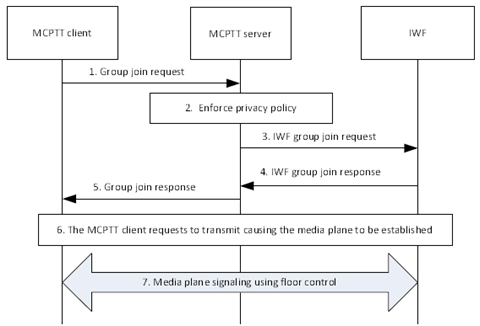
Step 1.
MCPTT user of the MCPTT client indicates to join the group communication for the group. The MCPTT client joins the group by sending a group join request to the MCPTT server. If there is a request to transmit, then the group join request contains an indication of an implicit floor request and the location of the joining party if required.
Step 2.
The MCPTT server inspects the Group join request for presence of location information of the calling party. If location information is included in the join request, the MCPTT server checks the privacy policy (authorisation to provide location information to other MCPTT users on a call when talking, as defined in TS 23.379 Annex A.3) of the requesting MCPTT user to decide if the user's location information may be provided to other MCPTT users on the call and the IWF.
Step 3.
The MCPTT server notices that the interworking group is defined in the LMR system and forwards the group join request with or without location depending on the outcome of the privacy check as an IWF group join request to the IWF.
Step 4.
The IWF replies with an IWF group join response indicating the acceptance of the group join request and also returns the IWF selected media parameters for the chat group call in the IWF group join response.
Step 5.
The MCPTT server forwards the IWF group join response to the MCPTT client as a group join response.
Step 6.
If the MCPTT client requests to transmit, the MCPTT server establishes the media plane (if not already established) for the call.
Step 7.
Floor control will continue to be used by the floor participants associated with the MCPTT client and the IWF for the duration of the call. Media plane signalling using floor control will be used for subsequent calls for the group as long as one or more users are affiliated.
10.3.5.3 LMR user initiated chat group call in an interworking group defined in MCPTT system p. 64
In this procedure, an LMR user initiates a chat group call in an interworking group defined in the MCPTT system. The signalling procedure is described in Figure 10.3.5.3-1.
Pre-conditions:
- The interworking group information is known at the IWF by configuration. The interworking group has been defined in the MCPTT system.
- MCPTT user 1 and MCPTT user 2 have previously joined (affiliated) to the group.
- The mapping relationship of group and user identities between the MCPTT system and the LMR system has been configured at the IWF.
- LMR user initiates a join to the group.
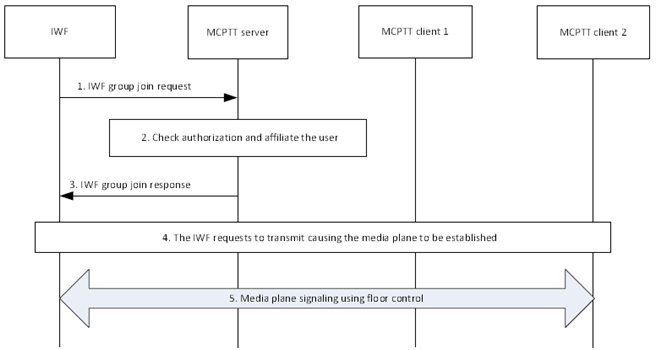
Step 1.
The IWF sends an IWF group join request to the MCPTT server. The request to join may contain location information of the transmitting party. If there is a request to transmit, then the IWF group join request contains an indication of an implicit floor request and the location of the joining party if required.
Step 2.
The MCPTT server checks whether the MCPTT ID is authorized to affiliate to the group. MCPTT server generates an implicit affiliation if the MCPTT ID is not already affiliated to the group.
Step 3.
The MCPTT server replies with a group join response indicating the acceptance of the group join request and also returns the MCPTT server selected media parameters for the chat group call in the IWF group join response.
Step 4.
If the IWF requests to transmit, the MCPTT server establishes the media plane (if not already established) for the call.
Step 5.
Floor control will continue to be used by the floor participants associated with MCPTT client 1, MCPTT client 2 and the IWF for the duration of the call. Media plane signalling using floor control will be used for subsequent calls for the group as long as one or more users are affiliated.
10.3.5.4 Release chat group call on an interworking group defined in the LMR system p. 65
This procedure describes the case where the LMR system releases an ongoing MCPTT chat group call on an interworking group defined in the LMR system, for all the participants of that group call. The signalling procedure is described in Figure 10.3.5.4-1.
Pre-conditions:
- A chat group call is ongoing involving an MCPTT client and the IWF.
- The LMR system initiates release of the chat group call.
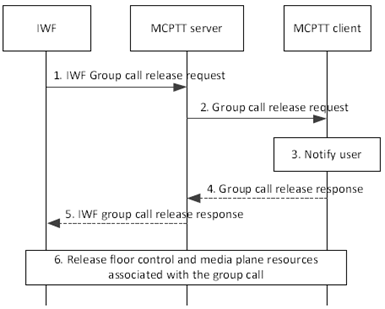
Step 1.
The IWF sends an IWF group call release request to the MCPTT server. An individual IWF group call release request is sent for each MCPTT user in the call.
Step 2.
MCPTT server forwards the release request(s) to the group's MCPTT users, as described in TS 23.379.
Step 3.
MCPTT users are notified about the release of the group call.
Step 4.
Optionally, the MCPTT client confirms the group call release request received in step 2 with a group call release response to the MCPTT server.
Step 5.
The MCPTT server forwards the group call release response to the IWF as an IWF group call release response.
Step 6.
The MCPTT client and the IWF release the floor control and media plane resources associated with the chat group call that is released. Successful release of the chat group call does not affect the status of affiliation of any of the clients.
10.3.5.5 Release chat group call on an interworking group defined in the MCPTT system p. 66
This procedure describes the case where the MCPTT server releases an ongoing MCPTT chat group call, on an interworking group defined in the MCPTT system, for all the participants of that group call, since at least one of the conditions for release are met e.g. due to hang time expiry, last participant leaving, second last participant leaving, initiator leaving, or the number of affiliated MCPTT group members is below the minimum number permitted.
The signalling procedure is described in Figure 10.3.5.5-1.
Pre-conditions:
- A chat group call is ongoing involving MCPTT clients 1, 2 and the IWF.
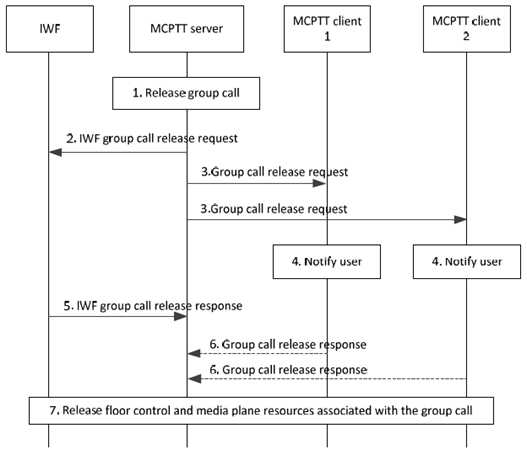
Step 1.
The MCPTT server decides to release the MCPTT chat group call which is ongoing e.g., due to hang time expiry, last participant leaving, second last participant leaving, initiator leaving, or minimum number of affiliated MCPTT group members are not present.
Step 2.
The MCPTT server sends an IWF group call release request to the IWF to release the ongoing session. If the IWF has joined itself to this group on behalf of all the group's LMR users, only one IWF group call release request message is sent to the IWF. If the MCPTT server has received individual joins from the group's LMR users, an individual IWF group call release request is sent to the IWF for each joined LMR user.
Step 3.
The MCPTT server sends a group call release request towards each MCPTT participant of the ongoing group call.
Step 4.
The MCPTT users are notified about the release of the group call.
Step 5.
The IWF confirms the IWF group call release request(s) received in step 2 by IWF group call release response(s) to the MCPTT server.
Step 6.
Optionally, the MCPTT client(s) receiving a group call release request may send a group call release response to the MCPTT server.
Step 7.
MCPTT client 1, client 2 and the IWF release the floor control and media plane resources associated with the chat group call that is released. Successful release of the chat group call does not affect the status of affiliation of any of the clients.
10.3.5.6 Void
10.3.5.7 Void
10.3.5.8 Newly joined MCPTT group member of a group defined in the LMR system |R16| p. 67
Procedures in Figure 10.3.5.8-1 are those for a group member entering an ongoing MCPTT group call, i.e. performing a late entry.
Pre-conditions:
- The MCPTT client is registered and the MCPTT user has been authenticated and authorized to use the MCPTT service.
- There is an ongoing group call on the group homed on the LMR system.
- The MCPTT client has not yet joined the group call.
- The MCPTT user indicates to join the group call.
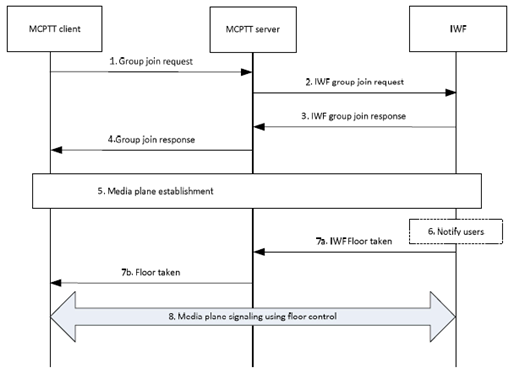
Step 1.
The MCPTT client sends a group join request with the MCPTT group ID of the desired group to the MCPTT server. If there is a request to transmit, then the group joint request contains an indication of an implicit floor request.
Step 2.
The MCPTT server forwards the request to the IWF.
Step 3.
The IWF replies with a group join response indicating the acceptance of the group join request.
Step 4.
The MCPTT server forwards the response to the MCPTT client.
Step 5.
The IWF establishes the media plane with the MCPTT client.
Step 6.
The IWF may notify its users that an MCPTT user has joined the group.
Step 7a.
The IWF sends an IWF floor taken (for the current talker) to the MCPTT server if the floor has been taken.
Step 7b.
The MCPTT responds to any incoming IWF floor taken message by forwarding a floor taken message to the MCPTT client.
Step 8.
Floor control will continue to be used by the floor participants.
10.3.5.9 Newly joined LMR group member of a group defined in the MCPTT system |R16| p. 68
Procedures in Figure 10.3.5.9-1 are those for the IWF entering an ongoing MCPTT group call, i.e. performing a late entry.
Pre-conditions:
- MCPTT user 1 and MCPTT user 2 have previously joined to the group.
- MCPTT users using MCPTT client 1 and MCPTT client 2 are in an ongoing group call.
- The IWF has not yet joined the group call.
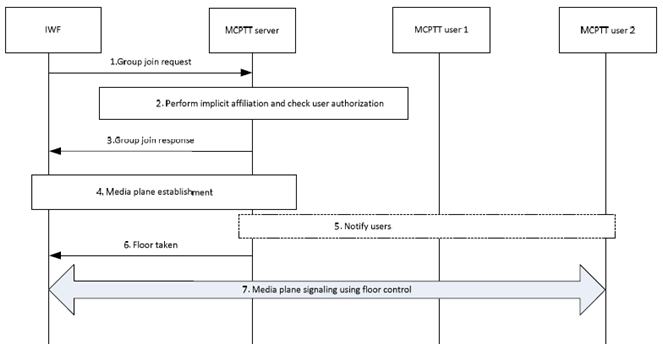
Step 1.
The IWF sends a group join request with the MCPTT group ID of the desired group and either using the MCPTT ID corresponding to the LMR group member or using the pre-configured MCPTT ID for use when the IWF is affiliating itself on behalf of the group's LMR users. If there is a request to transmit, then the group join request contains an indication of an implicit floor request. If the group join request includes an implicit floor request it may also include location information.
Step 2.
The MCPTT server receives the group join request. MCPTT server generates an implicit affiliation using the MCPTT ID used by the IWF (if the IWF or the LMR user is not already affiliated to the group) and verifies that IWF is authorized to affiliate to the group.
Step 3.
The MCPTT server replies with a group join response indicating the acceptance of the group join request.
Step 4.
The MCPTT server establishes the media plane between the IWF and the MCPTT server.
Step 5.
MCPTT users at MCPTT client 1 and MCPTT client 2 may be notified about the IWF joining the group call.
Step 6.
The MCPTT server sends a floor taken (for the current talker) to the IWF.
Step 7.
Floor control will continue to be used by the floor participants associated with MCPTT client 1, MCPTT client 2 and the IWF.
10.3.5.10 MCPTT client returning to coverage on a group homed in the LMR system |R16| p. 69
Procedures in Figure 10.3.5.10-1 are those for an MCPTT client returning to coverage during an ongoing MCPTT chat group call.
Pre-conditions:
- The MCPTT user using an MCPTT client is in an ongoing chat group call when the MCPTT client goes out of radio coverage.
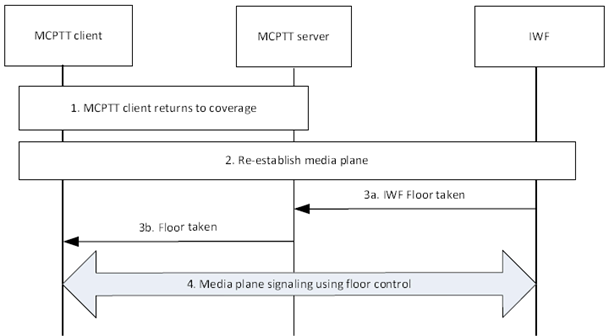
Step 1.
The MCPTT client or MCPTT server detects that MCPTT client has returned to coverage.
Step 2.
The media plane between the MCPTT client and the IWF are re-established using media plane control signalling.
Step 3a.
The IWF sends an IWF floor taken to the MCPTT server if anyone currently has the floor.
Step 3b.
The MCPTT server forwards a floor taken message to the MC Client if anyone currently has the floor.
Step 4.
Floor control will continue to be used by the floor participants.